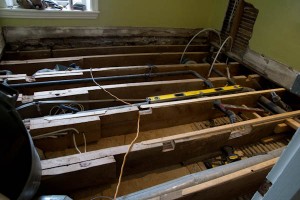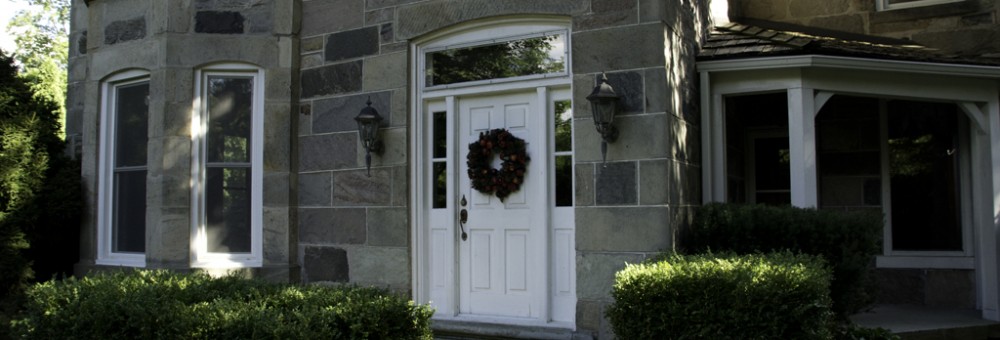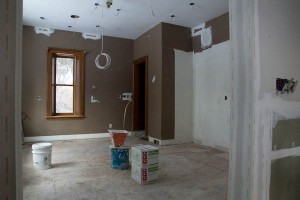For a number of reasons, HingeQuest needed to take a hiatus for a period of time. Upon its resumption, however, I already had a location in mind. The location in Cobourg was still out there (as Cobourg pretty much is, being 1.5 hours the other side of Toronto from our current stomping grounds). In the meantime, however, I had discovered another company specializing in the reclamation and salvage of old buildings.
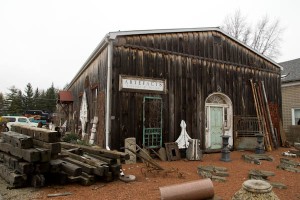
Artefacts in St. Jacobs. Knowledgeable, friendly, and – even better – with what we were looking for!
Artefacts is a company in St. Jacobs, and has been specializing in architectural salvage for more than 25 years. More particularly, theIr focus runs to the residential end of things. They specialize in reclaiming, refurbishing and restoring pretty much anything that can be extracted from old houses as they are being gutted or torn down. The two principals, Chris and Scott, are extremely hands-on, and – while I have only met Chris – also very knowledgeable about what it is they have, where it came from and why it is useful.

We came looking for hardware, and got distracted along the way by kitties.
The first thing we discovered upon entering Artefacts was that they have an incredible variety of doorknobs available. Actually, that’s not true. The first thing we discovered was that they have an amazing and incredibly affectionate cat. The second thing that we discovered was the doorknobs.
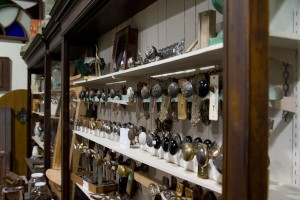
Knobs? Why, yes. We have knobs! What kind of knob would you like, specifically?
Where the doorknobs at Addison’s were relatively new (probably last 20 years, but still porcelain) what Artefacts sells are the real deal. Genuine, vintage, 19th century door hardware – including cross-bars, rosettes and (if you can figure out what kind of latch set you need) latch sets. Within five minutes of walking in the front door, we had three sets of porcelain doorknobs and one very cool latch set. What is wonderful about all of the hardware is that it has been completely refurbished, and is in spectacularly good shape.

One vintage latch set, complete with working lock, key mortise and porcelain knobs in gorgeous condition.
That merely set us up for our next discovery: hinges! First up, some beautiful reproduction hinges — replicating the right period, all in the right size, and with patterns that were similar to what we were looking for. Even better, once I had refocussed on the broader array of what was one offer, is that they also had antique hinges. Best, from our point of view, is that they had the exact antique hinges that we were looking for. Refurbished. And in sufficient quantities. Well, they had four sets of them. We bought the lot.

Hinges, we have hinges! Oh yes we do. HingeQuest is officially over. And Artefacts is out of stock.
We were also finally able to answer the question of where and when these hinges had come from. As it turns out, they were in fact the original article. They are cast iron hinges, manufactured and used largely in the late 1800s, and built to surprisingly specific standards. So the stamping of the dimensions on the back was not in fact evidence of reproductions; it was illustration of the fact that, even in the 1800s, some enterprising ironmongers had their collective bits together.
Our hinges are one of two patterns that were predominantly in use in the area of western Ontario in the late 1800s. The folks at Artefacts call it the ‘3E’ pattern, because that’s roughly what it looks like. There was also a slightly more ornate pattern, with ‘leaves’ branching from the main body of the design, that was also often found in houses of the period.

Wooden brackets, normally used as an architectural detail on Italianate buildings. Just like ours.
The last discovery before we left Artefacts was that they also have roof brackets. It was common in the design of Italianate houses (of which ours is one) that under the eaves of the roof appeared ornate wooden brackets, two at a time, that joined the upper wall and the soffit. At some point in a previous renovation, the brackets on Boo Manor disappeared. Artefacts happens to sell brackets that have been recovered from similar-era houses. While not in the scope of this project (you have to stop somewhere, after all) I have a feeling we will be back in the future to check them out.
